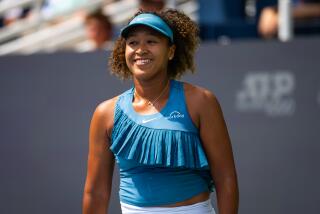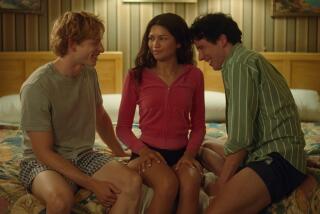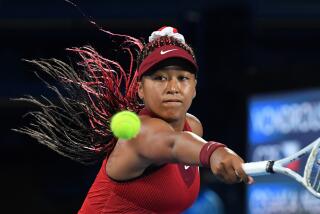DiToro Is Pushing Forward
Daniela DiToro is really stressing about her birthday, again. It’s hard to understand why.
Hitting 24 should be as easy to her as returning volleys.
DiToro is the top-ranked women’s wheelchair tennis player in the world and has breezed through the early rounds of the U.S. Open this week at the Racquet Club of Irvine. She travels seven months of the year, then returns home to Melbourne, Australia, where she is active in youth groups.
It’s a full life, but, come on, 24 and stressing out?
“I’m bad about that,” said DiToro, whose spinal cord was broken when a wall collapsed on her in 1988. “Every year I come to the U.S. Open and dread the knowledge that I’m going to be another year older.
“Every other tournament I feel relaxed, comfortable and at ease. For some reason, when I come here I tense up.”
Obviously there is more on her mind than just adding another candle to the cake.
DiToro, who describes herself as driven, looks on this as the most important event on the tour. She has been climbing in the rankings for years and has reached the top, in part by her victory in last year’s U.S. Open . . . when she was stressed about turning 23.
“I guess in everybody’s mind, this is the one big tournament,” DiToro said. “It has a different feel about it. Don’t get me wrong, they have great tournaments in Europe. Winning the British Open was great. But when you come to the U.S. Open, it feels like big stuff is happening.”
DiToro ended a 12-year hold by players from the Netherlands by winning the women’s singles title last year. It was the last trophy needed to complete her set, which includes hardware from the French, British and Australian opens.
“What’s great about this sport is on a good day, you maybe play to 80% of what you can do,” DiToro said. “So every day there are more boundaries to push. I’m always looking for that little extra.”
Tennis was not DiToro’s favorite, or best sport, before she was injured. She was an avid cricket, soccer and basketball player who also dabbled in other sports, such as tennis.
“I spent half my life up a tree,” DiToro said. “I did play a bit of tennis, but I wasn’t going to be a Steffi Graf or anything.”
That changed when she was injured at a school swim meet in Melbourne, one in which all students were required to compete. A large portion of a brick wall next to the pool collapsed on her.
DiToro was left paraplegic.
“The funny or ironic or tragic thing is, I suck at swimming,” DiToro said. “I had to be there. Anyone who wasn’t would get detention. There were 300 kids there and mine was the worst injury.
“I went from being 13 and incredibly active to not being able to walk.”
It didn’t stop her from competing.
A year later she was playing wheelchair tennis. It began as part of her rehabilitation. DiToro tried a few sports--she was on the national wheelchair basketball team for a time--before deciding that she liked the individual aspect of tennis.
She was competing locally for a time, then moved on to the world tour. She won her first tournament, the Australian Open, in 1991 and was ranked fifth in the world by 1993. DiToro had her best year in 1997, when she won five tournaments. She won her quarterfinals match Wednesday, defeating Chiyoko Ohmae of Japan, 6-2, 6-1.
“Being told I could play didn’t normalize my situation, but it did make it better,” DiToro said. “I can now play tennis better than any of my able-body friends. My brother still kicks me. He’s one of those people who picks up a racket once a year and beats people.
“It’s amazing. Certainly before the accident, I had no intention of playing tennis. This opened up a lot of possibilities instead of closing doors. I have done a lot of stuff that I wouldn’t have done if I hadn’t had the accident. I feel grateful and humble.”
DiToro does give something back. She returns home for five months, spending time with her mother and brother. She also works with youth groups.
“We get kids from different backgrounds. Some are living in the street; some are from correctional centers; some are from private schools,” DiToro said. “We give them a safe place to deal with some issues, from social abuse to their own goals.”
It would be tough to find a better role model than DiToro, who has come a long way in 10 years.
“It has been progressive with me,” DiToro said. “Obviously, I wanted to get active after the accident. I don’t know if you can call it stubborn, but I call it stubborn. My stubbornness is a little softer now. As I get older the clarity becomes a little clearer. I appreciate where I am rather than trying to get to the next level.”
Or the next birthday?
More to Read
Go beyond the scoreboard
Get the latest on L.A.'s teams in the daily Sports Report newsletter.
You may occasionally receive promotional content from the Los Angeles Times.











